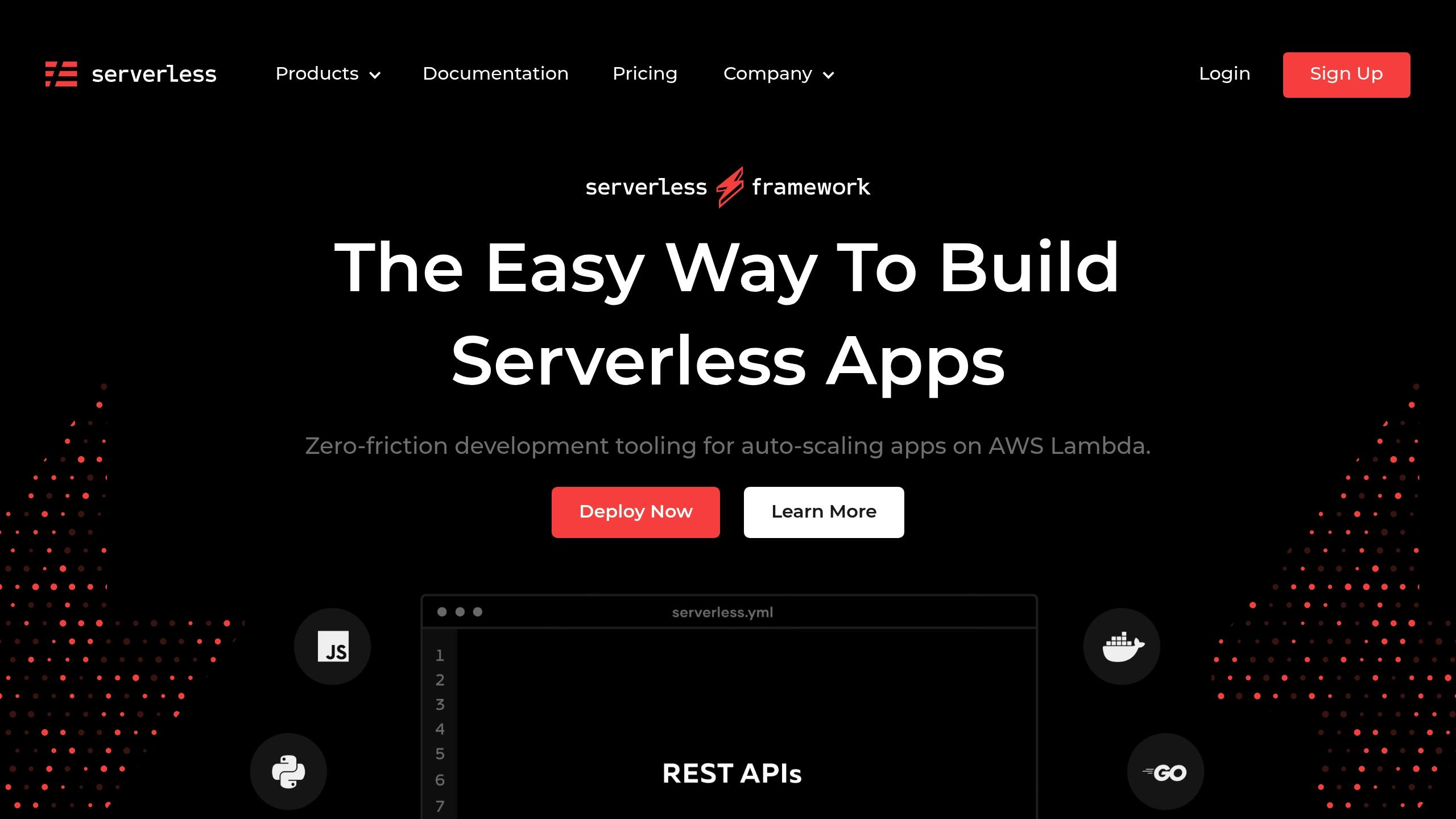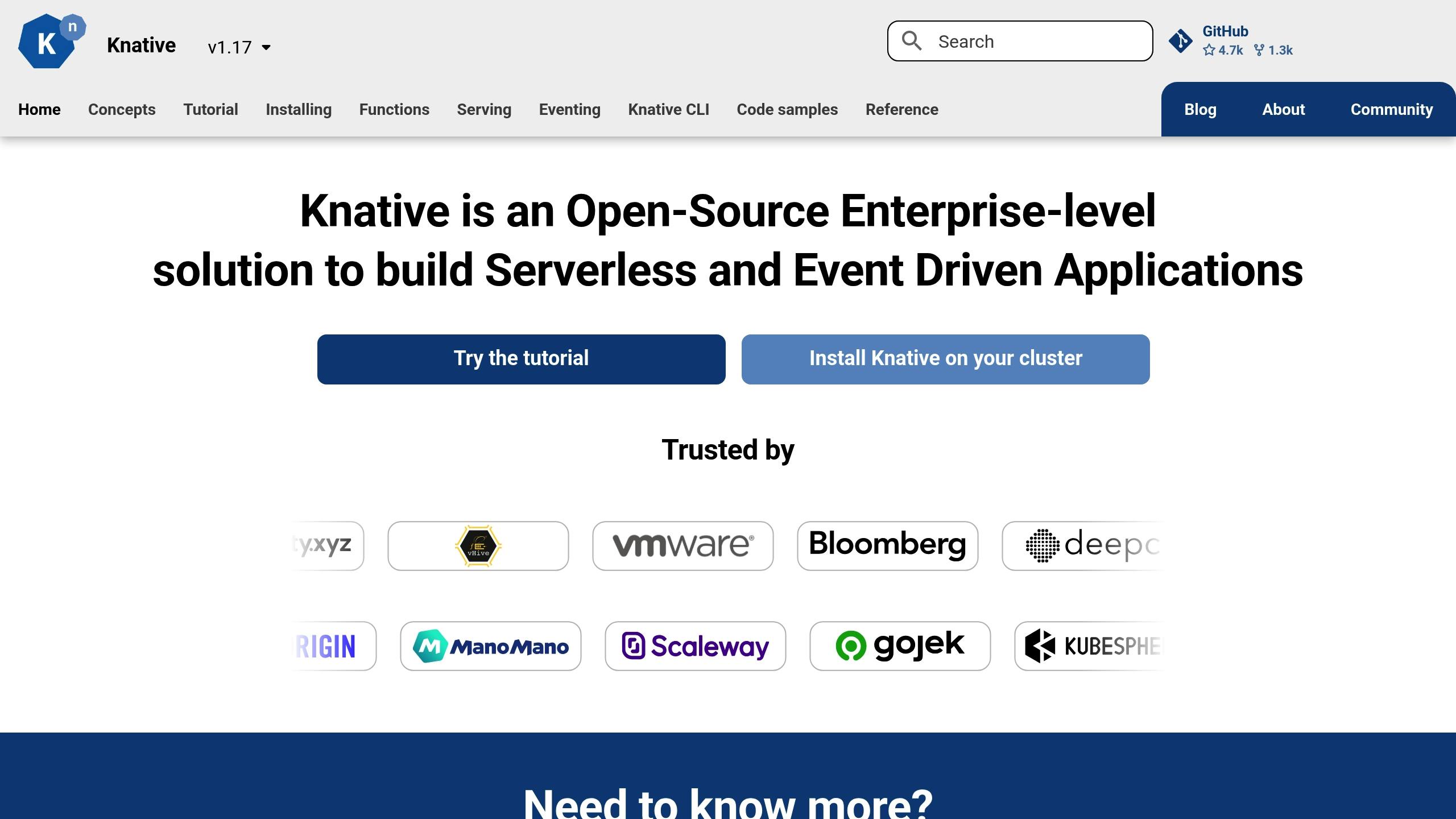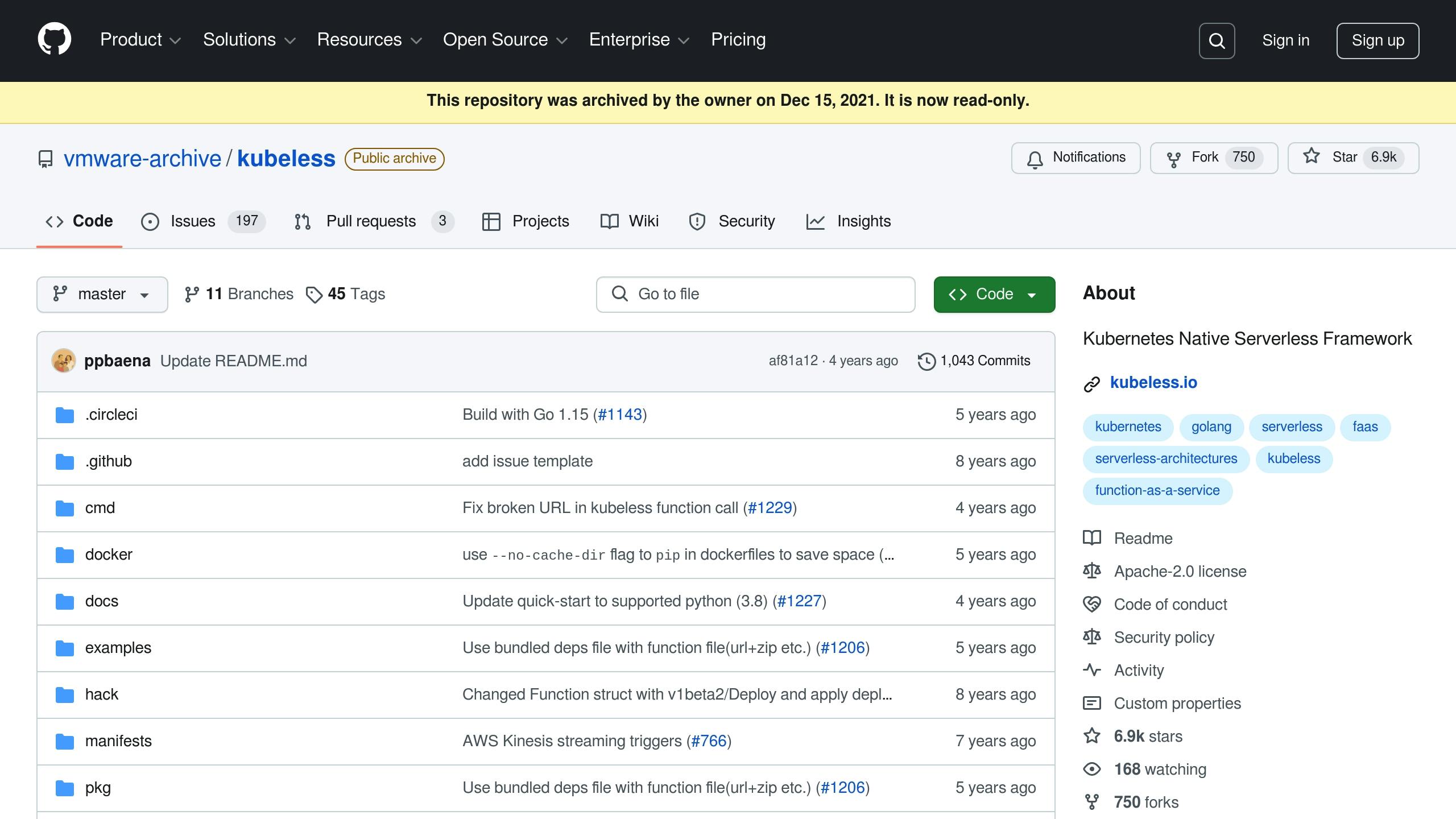Top 7 Open Source Serverless Frameworks for Scaling
Explore top open source serverless frameworks that enhance scalability, resource management, and performance for unpredictable workloads. serverless...
Explore the top 5 open-source serverless frameworks that simplify development, enhance scalability, and support AI-driven applications.
Serverless frameworks help developers focus on coding without worrying about infrastructure. Here’s a quick guide to the top 5 open-source serverless frameworks for building scalable, AI-driven applications:
| Framework | Scaling | Languages Supported | Key Features |
|---|---|---|---|
| Serverless Framework | Auto-scales via cloud providers | Node.js, Python, Java, Go, Ruby | Multi-cloud, plugins, rollback support |
| Apache OpenWhisk | Container-based scaling | Python, Node.js, Java, Swift | Event triggers, active community |
| Knative | Scales to zero, Kubernetes-based | Any containerized language | Modular, real-time scaling, event-driven |
| Kubeless | Kubernetes Horizontal Pod Autoscaling | Python, Node.js, Ruby, Go | Native Kubernetes, event source integration |
| Fission | Warm containers, executor-based | Python, Node.js, Go, Java, Ruby | Fast deployment, versioning, monitoring |
These frameworks are backed by active communities, ensuring frequent updates and robust support. Choose based on your project’s needs: scalability, language compatibility, and deployment options.

When selecting an open source serverless framework for modern AI-driven applications, it’s essential to focus on features that align with your project’s needs. Here are some key factors to guide your decision-making.
Look for frameworks that offer automatic scaling, handle concurrent execution limits, and optimize resources effectively. The framework should handle everything from a handful of requests to millions without compromising performance.
Choose frameworks that support a variety of programming languages and include libraries tailored for AI/ML tasks. This flexibility allows your team to:
Ensure the framework supports deployment across various environments, including:
These features help maintain smooth development workflows and prepare your project for future growth.
A strong community ensures better framework reliability. Evaluate:
The framework should allow for custom functionality and seamless integration of specialized components. This is especially important for building AI-powered features that may require unique tools or APIs.
"We improved our trial rates by 20% in 1 week after working with Optiblack leading to increase in paid users" - Anil Shanbag, CEO Dictanote
| Key Factor | Consideration Points |
|---|---|
| Scalability | Auto-scaling, resource limits, performance optimization |
| Language Support | Available runtimes, AI library compatibility |
| Deployment | Multi-cloud options, local development tools |
| Community | Update frequency, documentation quality, support channels |
| Integration | API flexibility, plugin architecture, custom extensions |
For AI-driven projects, focus on frameworks that offer scalability, flexibility, and robust integration capabilities. These features ensure your application can handle complex tasks and adapt to evolving needs.
The Serverless Framework is an open-source tool designed to make building and deploying serverless applications easier. Since its debut in 2015, it has gained a solid reputation for simplifying deployments and showcasing the core features of serverless technology.
A standout feature of the Serverless Framework is how it simplifies deployments while enabling cloud providers to handle scaling effortlessly. Its plugin-based architecture also helps address cold start issues.
The framework supports several programming languages, giving developers flexibility in their choice of tools:
With ready-to-use templates and plugins, it ensures a smooth deployment process across all these languages.
The Serverless Framework uses infrastructure-as-code principles to offer:
Its extensive plugin ecosystem further enhances its capabilities, covering areas like monitoring, security, CI/CD workflows, and development tools.
The framework benefits from a vibrant community of contributors who regularly provide updates, create plugins, and improve documentation. This active participation has been key to its growth and widespread use.

Apache OpenWhisk is an open-source serverless framework designed for building event-driven applications. It uses scalable event triggers and supports various integrations, making it a powerful tool for handling serverless workloads. Developed by a global community, it embodies the collaborative spirit of open-source development. This approach aligns with the growing adoption of serverless architecture in modern application design.

Knative is a platform built on Kubernetes that simplifies running serverless applications across different environments. Initially developed by Google in 2018, it has since grown through contributions from the open-source community, showcasing the collaborative nature of modern serverless frameworks.
Knative's Serving component handles automatic scaling for containerized workloads. This feature allows organizations to adjust resources based on demand, helping to manage costs effectively.
Knative supports any programming language that can be containerized. Whether you're working with Java, Python, Node.js, Go, PHP, .NET, Rust, Ruby, or Kotlin, Knative provides the flexibility to use your preferred tools.
Knative's architecture is built around two main components:
Knative works seamlessly with Kubernetes tools and supports various deployment strategies. Its modular design also allows teams to create custom integrations while staying compatible with the core system, making it highly adaptable to unique requirements.
Knative has a growing community of contributors who actively improve the platform. Regular updates bring security fixes and performance improvements, ensuring Knative remains a strong option for serverless application development.

Kubeless is a serverless framework designed specifically for Kubernetes. It streamlines the process of deploying and managing serverless functions directly within Kubernetes environments.
Kubeless offers several tools and features that make it a practical choice for managing serverless workloads:

Fission is a lightweight serverless framework designed for Kubernetes. It allows developers to deploy functions quickly without needing to build container images, speeding up both development and testing.
Fission supports several programming languages, including Python, Node.js, Go, Java, .NET Core, PHP, and Ruby. It uses pre-configured environment containers to simplify the development process.
Fission ensures fast function deployment by using warm container pools, reducing delays caused by cold starts.
Some standout features include:
Fission is built to handle demanding workloads efficiently. Key features include:
These capabilities make Fission a strong choice for serverless applications on Kubernetes.
Fission benefits from an active community of developers and enterprise users who regularly contribute to its growth. This ongoing collaboration helps ensure the framework continues to improve and evolve.
Here's a look at how five popular open-source serverless frameworks handle scaling:
| Framework | Scaling Capabilities |
|---|---|
| Serverless Framework | Automatically scales within the limits set by the cloud provider. |
| Apache OpenWhisk | Scales using containers, allowing for concurrent activations. |
| Knative | Built for Kubernetes, it offers scaling, including the ability to scale down to zero. |
| Kubeless | Auto-scales functions using Kubernetes Horizontal Pod Autoscaling. |
| Fission | Employs warm container pools and an executor-based approach for scaling. |
Each framework offers distinct scaling features, so it's important to select one that aligns with your application's specific requirements.
Next, we’ll dive into how the open-source community influences these frameworks.
The open source community plays a key role in shaping serverless frameworks through collaborative development and ongoing feedback. Their efforts help refine these platforms, tackling technical challenges as they arise.
Boosting Security Through Collaboration
Developers work together to spot vulnerabilities and make critical updates, like improving authentication systems and implementing role-based access controls. This teamwork helps maintain strong security measures.
Integrating AI Features
Thanks to community contributions, AI capabilities are now a part of these frameworks. This includes support for serving machine learning models, better auto-scaling, and resource optimization. These AI-driven features make frameworks more effective in real-world production settings.
Solving Practical Problems
Community-driven problem-solving speeds up project launches and improves performance, showing how collective input leads to measurable improvements.
Staying Aligned with Industry Trends
Regular feedback from developers ensures these frameworks keep up with changing technical needs. For example, insights from the community have led to better support for edge computing and container integration, addressing current industry priorities.
Improving the Developer Experience
Updates inspired by the community make it easier to troubleshoot issues and learn the technology, encouraging more developers to adopt serverless tools. These changes tie directly to the technical progress discussed earlier.
The open source community’s collaborative approach ensures that serverless frameworks evolve alongside technological advancements, all while maintaining strong security and usability. Their collective expertise and real-world insights continue to shape the future of serverless computing.
Open source serverless frameworks play a key role in building scalable digital products and AI-driven solutions. Each framework discussed offers distinct advantages tailored to various development needs.
When choosing a framework, consider these three factors:
A great example of effective implementation comes from TaxplanIQ. Their COO Joli Rosario shared:
"We needed a way to optimize our SaaS website. Since engaging with Optiblack we have seen a 102% increase in our MRR." [1]
To get started with serverless solutions:
The success of serverless adoption depends on careful planning and execution. With ongoing advancements fueled by community contributions, these frameworks continue to shape the future of AI and digital innovation. Embracing them now ensures your applications are efficient, scalable, and ready for what's next.
When choosing an open-source serverless framework for AI-powered applications, consider a few key factors to ensure it meets your needs. Scalability is crucial, as AI workloads often require handling large datasets and computational power efficiently. Look for frameworks that can scale seamlessly with demand.
Another important factor is community support and documentation. A strong, active community can provide valuable resources, updates, and troubleshooting help. Comprehensive documentation ensures you can implement and maintain the framework effectively.
Lastly, evaluate the framework's integration capabilities. It should support the tools, libraries, and cloud providers you rely on for your AI projects. By aligning these features with your specific requirements, you can choose a framework that boosts productivity and simplifies development.
Community involvement plays a critical role in shaping the growth and reliability of open-source serverless frameworks. Developers from diverse backgrounds contribute code, identify bugs, and suggest improvements, which leads to more robust and innovative solutions. This collaborative effort ensures that frameworks evolve to meet the needs of a wide range of users.
Additionally, active communities often provide extensive documentation, tutorials, and forums, making it easier for new users to adopt and effectively utilize these tools. The shared knowledge and real-world testing by a global user base enhance the overall stability and scalability of the frameworks.
Kubernetes-based serverless frameworks like Knative and Kubeless provide several unique advantages for developers and organizations looking to build scalable, cloud-native applications.
Seamless Kubernetes Integration: These frameworks run directly on Kubernetes, allowing you to leverage its robust container orchestration capabilities while simplifying deployment and scaling.
Flexibility and Portability: Since they are Kubernetes-based, they are highly portable across any environment that supports Kubernetes, whether it's on-premises, in the cloud, or hybrid.
Community-Driven Development: Both frameworks are open source, benefiting from active community contributions that ensure continuous improvement and innovation.
By choosing solutions like Knative or Kubeless, you can combine the power of Kubernetes with the simplicity of serverless architecture, enabling efficient and scalable application development tailored to your needs.
Explore top open source serverless frameworks that enhance scalability, resource management, and performance for unpredictable workloads. serverless...
Discover how we built a robust campaign management system with seamless platform integration, real-time previews, and efficient state management.
Explore the differences between horizontal and vertical scaling in PaaS to optimize performance, cost, and reliability for your applications.
Be the first to know about new B2B SaaS Marketing insights to build or refine your marketing function with the tools and knowledge of today’s industry.